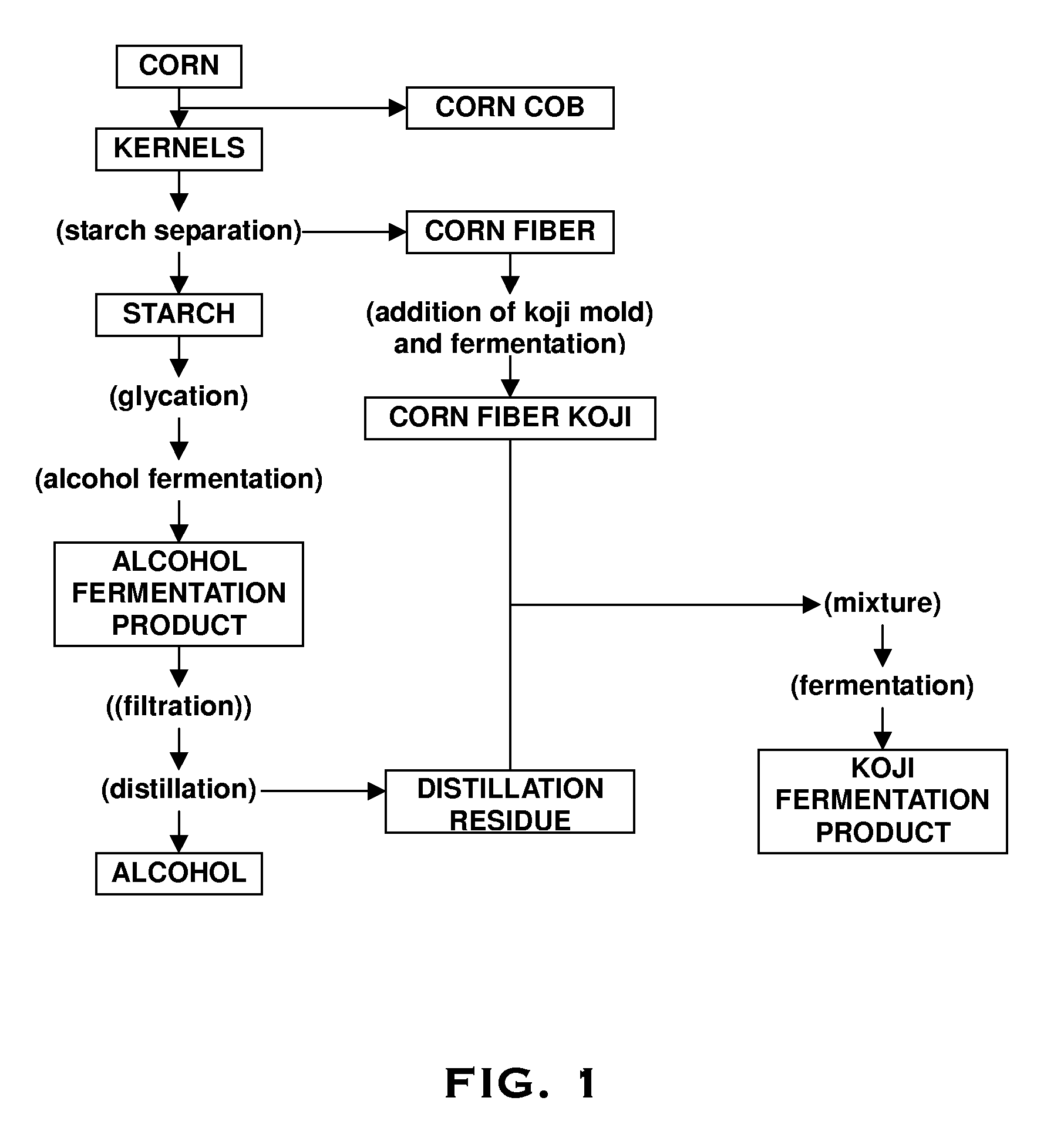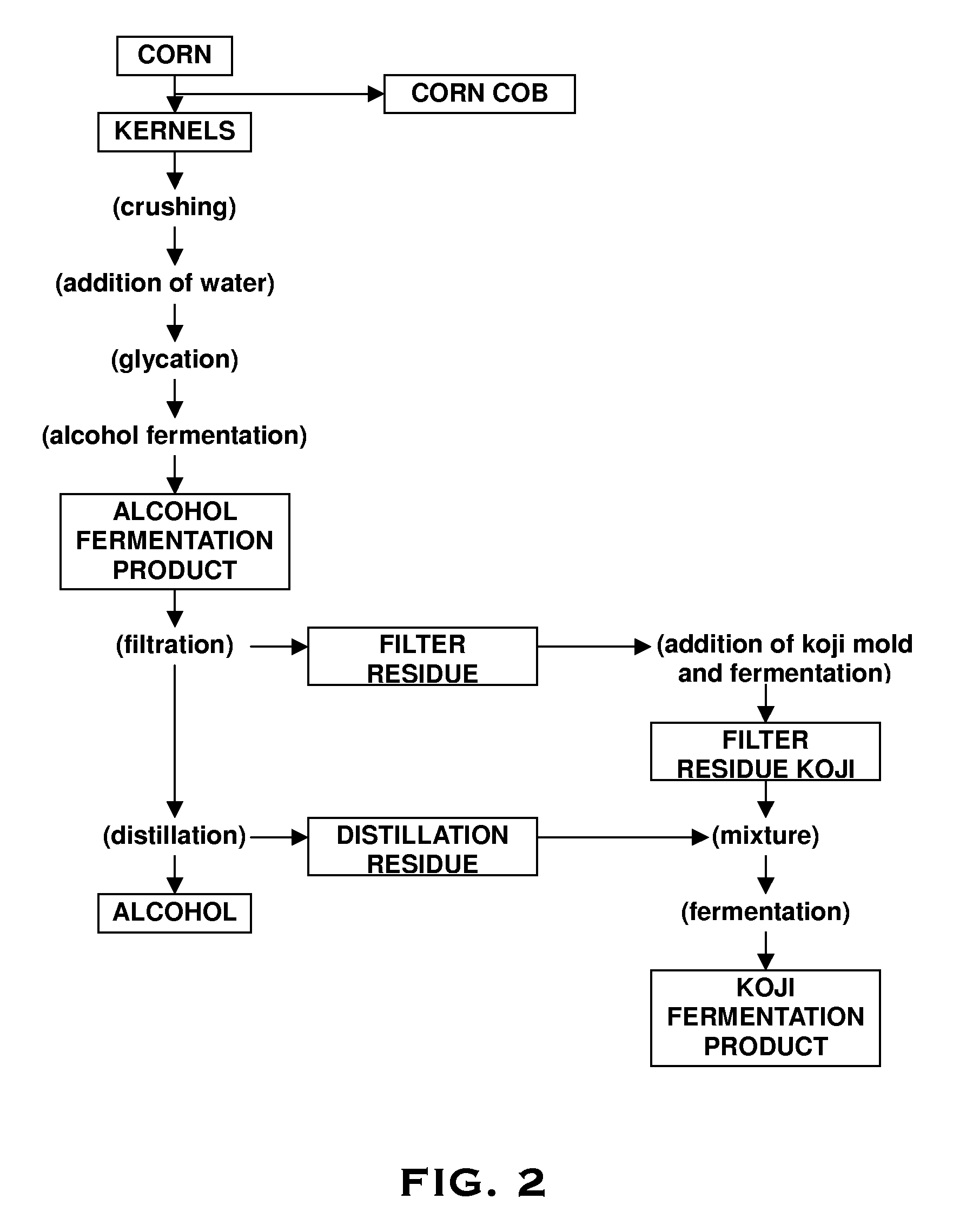Method of treating waste from alcohol production
a technology of alcohol production and waste, applied in the field of waste treatment, can solve the problems that the use of various byproducts has not been adequately effective, and achieve the effect of efficient treatment and convenient transportation
- Summary
- Abstract
- Description
- Claims
- Application Information
AI Technical Summary
Benefits of technology
Problems solved by technology
Method used
Image
Examples
example 1
[0048]Koji mold spores (108-109 per g of culture) were added to 1 kg of sterilized corn fiber with a water content adjusted to 35 wt % and mixed well, then loaded into a stationary ventilated koji maker. Ventilation was performed to control the heat generated with the growth of the koji mold to a suitable temperature (30-50° C.). 100 hours later, the water content had decreased to 20 wt %. An ethanol distillation residue (raw material: corn) with a water content of 95% was added, and mixed well to achieve a water content of 30%. The fermentation was continued for another 24 hours in the stationary ventilated koji maker. Ventilation was performed to maintain a suitable temperature (30-50° C.). Upon reaching a water content of 20 wt %, another 150 ml of ethanol distillation residue were added, and similarly fermented. This was repeated 30 times. During this time, koji mold spores (108-109 per g of culture) were added each week. As a result, 1 kg of a fermentation product was obtained....
example 2
[0049]Koji mold spores (108-109 per g of culture) were added to 1 kg of sterilized corn fiber with a water content adjusted to 35 wt % and mixed well, then loaded into a stationary ventilated koji maker. Ventilation was performed to control the heat generated with the growth of the koji mold to a suitable temperature (30-50° C.). 100 hours later, the water content had decreased to 20 wt %. 195 ml of an ethanol distillation residue (raw material: corn) with a water content of 80% and 6 ml of a edible waste oil were added, and mixed well to achieve a water content of 30%. The fermentation was continued for another 24 hours in the stationary ventilated koji maker. Ventilation was performed to maintain a suitable temperature (30-50° C.). Upon reaching a water content of 20 wt %, another 195 ml of ethanol distillation residue were added, and similarly fermented. This was repeated 30 times. During this time, koji mold spores (108-109 per g of culture) were added each week. As a result, 1 ...
example 3
[0050]455 ml of ethanol distillation residue (raw material: corn) and 100 g of wheat bran were added to 1 kg of corn cobs and mixed together. Next, koji mold spores (1.1×108-9 per g of culture) were added. A raw material mixture with the raw materials mixed together in this way was loaded into a stationary ventilated koji maker. With the growth of the koji mold, heat generation began about 12 hours after mixture of the koji mold. Ventilation was suitably performed to control this heat generation to a suitable temperature (30-50° C.). In the latter half, hot air passed through a steam heater was blown in order to achieve more efficient drying. As a result, 1 kg of a fermentation product was obtained. This was fed to pigs.
PUM
| Property | Measurement | Unit |
|---|---|---|
| water content | aaaaa | aaaaa |
| temperature | aaaaa | aaaaa |
| temperature | aaaaa | aaaaa |
Abstract
Description
Claims
Application Information
 Login to View More
Login to View More - R&D
- Intellectual Property
- Life Sciences
- Materials
- Tech Scout
- Unparalleled Data Quality
- Higher Quality Content
- 60% Fewer Hallucinations
Browse by: Latest US Patents, China's latest patents, Technical Efficacy Thesaurus, Application Domain, Technology Topic, Popular Technical Reports.
© 2025 PatSnap. All rights reserved.Legal|Privacy policy|Modern Slavery Act Transparency Statement|Sitemap|About US| Contact US: help@patsnap.com


